If installed properly, a chain link fence can be a solid, cheap way of fencing off a garden but it does rely on the preparatory work. The chain link itself is literally hung onto straining wires.
Chain link fencing is heavy and if the straining wires are not taught, or the posts that hold the wire are not strong or stable enough, the chain link will sag and look dreadful as well as being totally useless for the job it is supposed to be doing.

Birdsmouth straining post fitted to end post
Post Spacing for a Chain Link Fence
To fit chain link properly, Concrete in your fence posts as you would for a panelled fence except that instead of making them 6 feet apart, you only need them every 10 feet, or 3m.
The end posts should be in line but the front face of any intermediate posts should line up with the centre of the end posts. I. E Intermediate posts should be 50mm back from the end posts.
Supporting the Chain Link Fence end Posts
The posts at either end of the fence run take the most strain so they must have straining posts fitted to them. The image above shows a straining post fitted at approximately 45 degrees to the upright post.
The image is done in two colours so you can see the shape of the joint that needs to be cut out of the upright post for a solid job. This joint is called a birdsmouth joint. You can see more about this joint, often used on roofs, in our birdsmouth project.
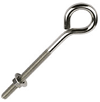
Steel eyebolt
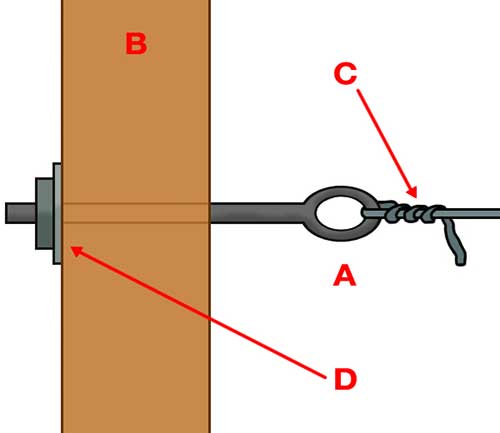
Fixing eyebolt
Fixing Eye Bolts and Line Wires for a Chain Link Fence
The bottom of the straining post should be concreted also. At the top (B) in the above image and bottom height of your chain link, drill a 10mm hole in the centre of the post and push an eye bolt through. The nut should be on the end of the thread giving the maximum adjustment when it is turned. Do this on each of the end posts.
Now use the line wire (C) supplied with the roll of chain link to tie to the eye bolt at point A in the diagram above. Twist it over itself 3 or 4 times using fencing pliers.
The wire should be pulled as tight as possible by hand and a galvanised staple tacked over the wires as they pass by the intermediate posts. The staples should not be banged in completely yet.
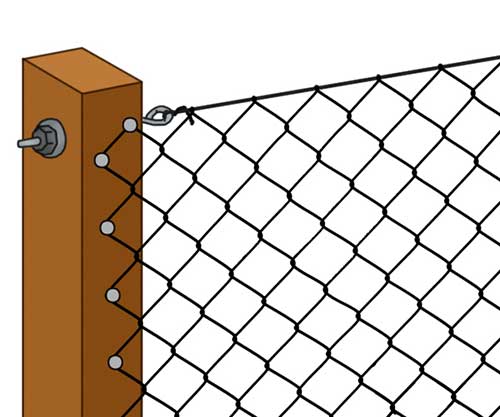
Chain link fence
Tightening the Chain Link Line Wire
Next tighten the nuts on all of the eye bolts. This will tighten the line wire as tight as it can be both top and bottom. Please note, if you are fitting a chain link fence over 1.2m or 4 feet high, you should use a central line wire as well as the top and bottom ones.

Galvanised staple
Fixing the Chain Link Fencing
When the line wires are tight, take the roll of chain link and stand it against one of the end posts. Staple every loop to the post after fixing the top of the fence to the line wire.
Unroll the wire after banging the intermediate staples in hard. Fix the top of the roll every 150mm or 6 inches with tie wire. The bottom of the roll can be fixed less regularly but this is not advisable.
Using a Turnbuckle for Extra Adjustment
Sometimes, with longer spans between posts, the eye bolts do not tighten the line wire enough. In these cases you can insert a turnbuckle by hooking it over the eyebolt first, then tying the line wire to the other end.
This will give you the adjustment available from the eyebolt, plus the turnbuckle adjustment.
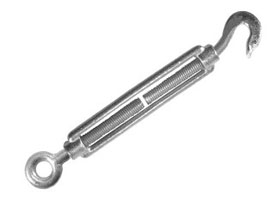
Use a turnbuckle for additional adjustment
Fixing Chain Link Fences to Concrete Posts
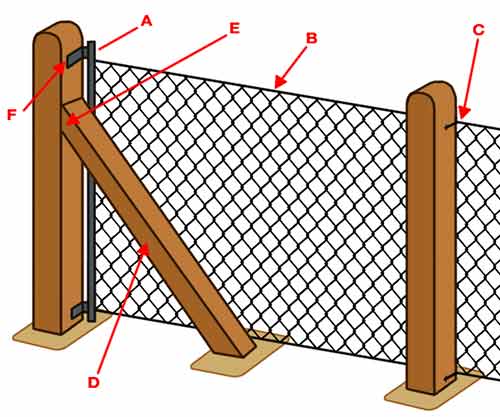
Diagram of chain link to concrete posts
Fixing chain link fencing to concrete posts is a similar procedure except Stretcher bars are used instead of trying to nail staples to a concrete post!
Concrete fence posts come pre drilled for eye bolts so the eye bolts still go in position F in the diagram above.
The line wire (B) is twisted and tightened in the same way, using a turnbuckle if necessary. The straining post (D) is shown surrounded by concrete and the birdsmouth joint (E) is already formed in concrete end posts.
At point (C) on every intermediate post, a Stirrup wire is used to tie the fence to the post. The stirrup wire can simply be a piece of line wire pushed through the hole in the post and twisted round the top of the fence.
Some Stretcher bars are equipped with a winding bracket which take the place of the eye bolt and turnbuckle. These do make life considerably easier but are a little more expensive so talk to your supplier to see if you can get a good deal.
If you prefer a less obvious fence than the galvanised silver of traditional chain link fencing, Green pvc coated chain link fencing could be the answer. This is fitted in exactly the same way.
Putting up a chain link fence in your garden is a quick, cheap and easy way of securing your garden or any other similar outdoor space and as long as you take your time and prepare everyting correctly, one that wil last a good long while.

